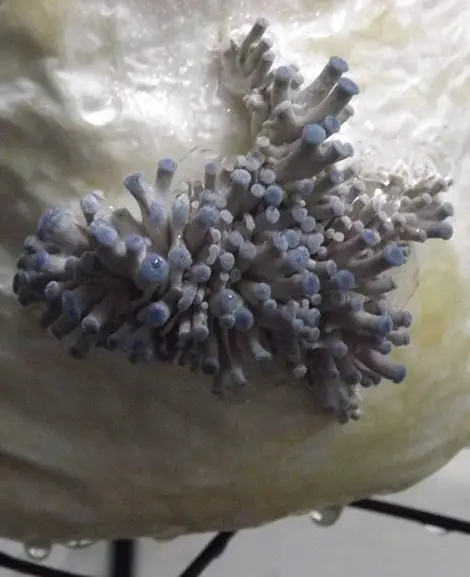The Ultimate Guide to Growing Blue Oyster Mushrooms (Pleurotus ostreatus var. columbinus)
Blue Oyster mushrooms (Pleurotus ostreatus var. columbinus) are one of the most popular and beginner-friendly gourmet mushrooms to cultivate. Known for their beautiful blue-gray caps, dense clusters, and robust umami flavor, these mushrooms are ideal for home growers and commercial farmers alike. Their fast growth, high yield, and adaptability to a wide range of substrates make them a go-to option for anyone interested in growing Blue Oyster mushrooms.

In this guide, you’ll learn everything you need to know about cultivating Blue Oyster mushrooms—from choosing the right substrate and spawn to managing fruiting conditions, harvesting, and troubleshooting. Plus, we’ll share trusted resources like The Spore Depot, where you can find high-quality spawn and supplies.
Why Choose Blue Oyster Mushrooms?
✔ Fast-growing: Fruiting in as little as 10–14 days
✔ Cold-tolerant: Performs well in cooler climates (55–65°F)
✔ High-yielding: Produces large flushes in ideal conditions
✔ Flavorful and versatile: Earthy, meaty taste, ideal for sautés and soups
✔ Aesthetically appealing: Clusters of blue-gray caps stand out at markets
Getting Started: What You’ll Need
Before growing Blue Oyster mushrooms, gather the following essentials:
- Blue Oyster mushroom spawn (grain, sawdust, or liquid culture)
- Substrate material (straw, sawdust, cardboard, etc.)
- Containers (filter patch bags, buckets, or grow boxes)
- Clean environment (still air box or sanitized workspace)
- Humidity, temperature, and light controls
✅ Spawn and supplies available at The Spore Depot
Step-by-Step Guide to Growing Blue Oyster Mushrooms
Step 1: Choosing the Right Substrate
Blue Oysters are flexible and can grow on various cellulose-rich materials. The best substrates include:
- Wheat straw (most common)
- Hardwood sawdust (oak, maple, beech)
- Coffee grounds (mixed with straw or cardboard)
- Cardboard and paper waste (for DIY home grows)
- Coco coir, sugarcane bagasse
Substrate Recipe for Maximum Yield:
- 80% chopped straw or hardwood sawdust
- 20% wheat or rice bran (optional but increases nutrients)
- Water to achieve 60–65% moisture content (feels like a damp sponge)
Step 2: Pasteurize or Sterilize the Substrate
Proper substrate preparation prevents contamination.
- Pasteurization (for straw): Soak straw in water at 160–170°F (71–77°C) for 1–2 hours. Drain and cool before use.
- Sterilization (for sawdust): Pressure cook at 15 PSI for 90–120 minutes.
🛒 Get pre-pasteurized substrate blocks at The Spore Depot if you want to skip this step.
Step 3: Inoculating with Blue Oyster Mushroom Spawn
Once the substrate is cooled and ready:
- Wear gloves and sanitize your workspace.
- Mix in Blue Oyster spawn at 5–10% of the substrate’s weight.
- Pack substrate into filter patch grow bags or drilled buckets.
- Label bags with date and strain.
Choose grain spawn for best results; it’s easy to distribute evenly and colonizes quickly.
Step 4: Incubation (Colonization Phase)
Place your inoculated bags or buckets in a dark, warm space for mycelium to colonize the substrate.
📍 Ideal incubation conditions:
- Temperature: 70–75°F (21–24°C)
- Humidity: 65–75%
- Light: Not necessary
- Duration: 10–14 days
The substrate will turn bright white as it becomes fully colonized. Tiny pins (primordia) may start to form during the final days.
Step 5: Fruiting Blue Oyster Mushrooms
Once the substrate is colonized, it’s time to introduce fruiting conditions.
📍 Fruiting environment settings:
- Temperature: 55–65°F (13–18°C)
- Humidity: 85–95%
- Light: Indirect or fluorescent light, 12 hours/day
- Fresh Air Exchange: At least 3–5 times/day (or use a fan or air pump)
Cut slits into the grow bag or open the lid of the container to expose the mycelium to fresh air. This change in CO₂ levels and humidity will trigger pinning.
Step 6: Harvesting Blue Oyster Mushrooms
Harvest mushrooms before caps flatten out completely, while they are still slightly curled at the edges. The mushrooms should be firm and deep blue (fading to gray as they mature).
🔪 Cut the whole cluster at the base using a sharp knife or scissors.
💡 Pro Tip: Harvesting earlier improves shelf life and texture.
Step 7: Storing and Cooking Blue Oyster Mushrooms
📦 Storage:
- Store fresh mushrooms in a paper bag in the fridge for up to 7 days
- Avoid plastic (causes moisture buildup and spoilage)
- Dehydrate at 110°F (43°C) for long-term storage
🍳 Culinary uses:
- Great for sautés, stir-fries, pastas, and soups
- Has a “meaty” bite—popular as a vegan meat substitute
- Pairs well with garlic, butter, soy sauce, and herbs
Tips for Successful Blue Oyster Mushroom Cultivation
Humidity and Fresh Air Are Critical
Blue Oysters are CO₂ sensitive—insufficient fresh air will result in long, thin stems and small caps (a condition known as “legginess”). Use fans, open windows, or CO₂ monitors to improve air quality.
Flush and Repeat
After your first harvest, rest the block for a few days, then soak in cold water for 4–6 hours to encourage a second flush. You can typically get 2–3 flushes from a single grow bag.
Pest Control
Watch out for fungus gnats and mold, especially in warm and humid environments. Cleanliness and proper sterilization are your best defenses.
Common Problems When Growing Blue Oyster Mushrooms
| Problem | Cause | Solution |
|---|---|---|
| Thin, leggy mushrooms | High CO₂, poor airflow | Improve fresh air exchange |
| Green mold contamination | Poor sterilization or sanitation | Improve substrate prep and workspace |
| Mushrooms drying out | Low humidity | Mist more or add a humidifier |
| Delayed or no fruiting | Substrate too dry, temperature too high | Rehydrate and adjust environment |
Trusted Sources for Supplies and Learning
Where to Buy Spawn and Supplies
- ✅ The Spore Depot – Blue Oyster mushroom spawn, kits, and liquid culture
- Field & Forest – Commercial-grade supplies
Authoritative Guides and Resources
- Cornell Small Farms Project – Mushroom Cultivation Resources
- The Spore Depot Blog – Oyster Growing Tips
- Fungi Ally – Blue Oyster Growing Tips
- Growing Gourmet and Medicinal Mushrooms by Paul Stamets
Conclusion: Start Growing Blue Oyster Mushrooms Today
Growing Blue Oyster mushrooms (Pleurotus ostreatus var. columbinus) is a fun, fast, and rewarding experience for growers of all skill levels. Whether you’re cultivating for personal use, farmer’s markets, or gourmet restaurants, Blue Oysters offer great yields, excellent taste, and striking visual appeal.
By following the steps outlined in this guide and sourcing quality spawn and supplies from trusted vendors like The Spore Depot, you’ll be well-equipped to produce beautiful, high-quality mushrooms consistently.
With just a little space and a few weeks of care, you can enjoy fresh, homegrown Blue Oyster mushrooms right from your kitchen or grow room.
#BlueOysterMushrooms #GrowingBlueOysterMushrooms #PleurotusColumbinus #TheSporeDepot #MushroomFarming #GourmetMushrooms #FungiCultivation #HomeGrowing





